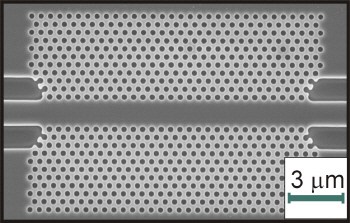Physicists have measured the photonic band structure of a photonic material for the first time (H Gersen et al. 2005 Phys. Rev. Lett. 94 123901). Laurens Kuipers of the FOM Institute for Atomic and Molecular Physics (AMOLF) and colleagues in the Netherlands, Belgium and Scotland developed a near-field optical microscope that can measure both the amplitude and phase of a light pulse as it travels through a photonic crystal.

Photonic crystals are materials in which a periodic variation of the dielectric constant results in a photonic band gap. Photons with wavelengths or energies in this gap cannot travel through the crystal. However, by introducing defects into photonic crystals it is possible to build “waveguides” that can channel light along certain paths (figure 1).
Existing methods to study photonic band structures compare the shapes of pulses leaving the crystal with the shapes of those entering. However, such techniques cannot identify exactly where the changes take place inside the device, and therefore provide only limited information about the band structure.
The near-field scanning optical microscope developed by Kuipers and colleagues employs a fibre-optic probe to measure variations in the intensity of the light waves that are produced on the surface of the crystal by a femtosecond laser pulse as it travels through a waveguide (figure 2).
“This is the first comprehensive determination of a photonic band structure,” Kuipers told PhysicsWeb. “Moreover, we actually see how the shape of the light waves is changed as they are forced to comply with the periodicity of the photonic crystal.”
The technique also allows the directions of the phase and group velocities of the light to be determined, and shows that under certain conditions the phase velocity can be negative while the group velocity is positive. The team now plan to study an array of phenomena – including negative refraction – with the technique.




